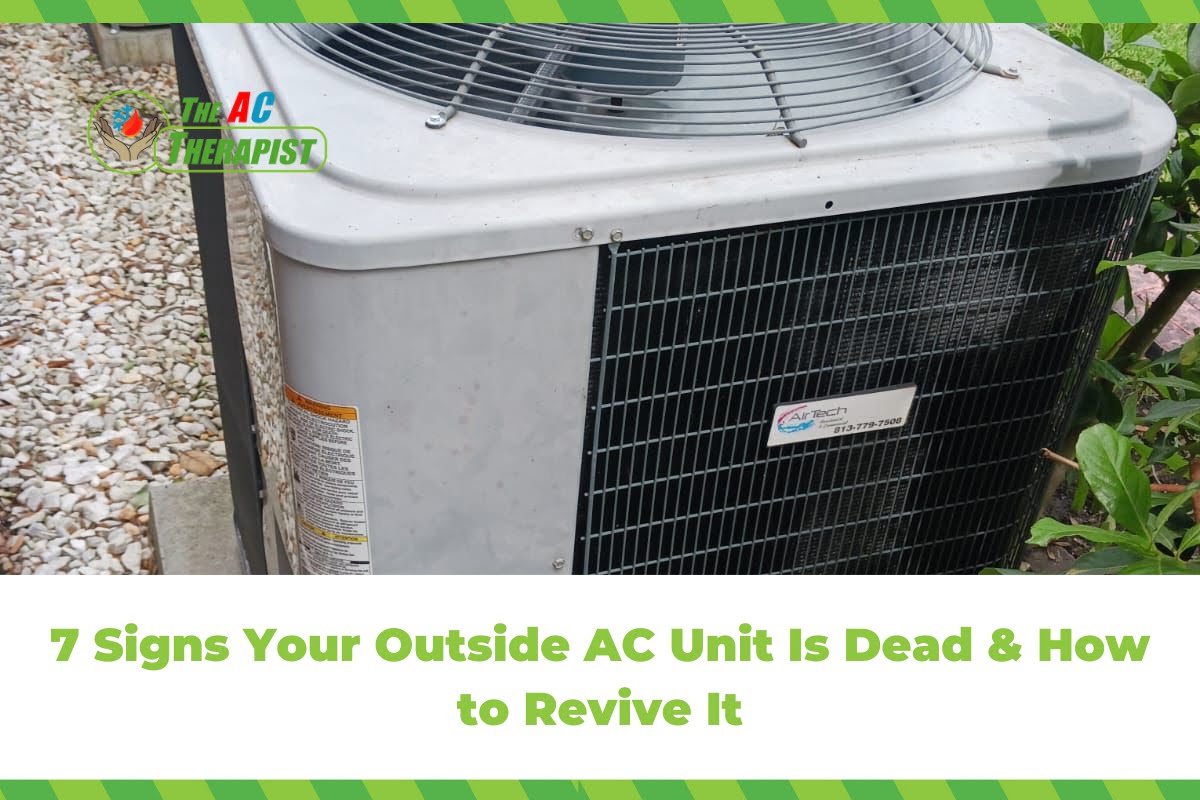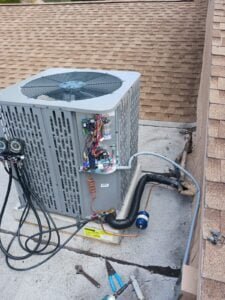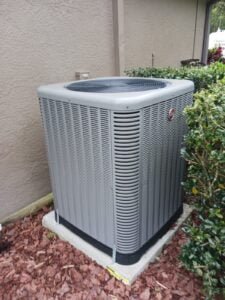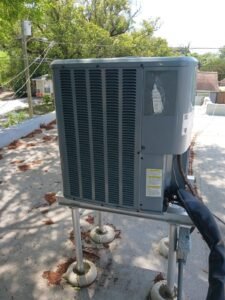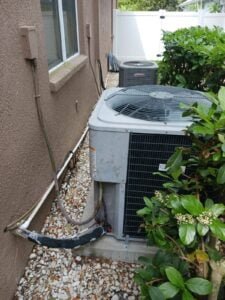7 Signs Your Outside AC Unit Is Dead & How to Revive It
When your home’s outside AC unit fails to kick into action, it doesn’t just disrupt your comfort—it challenges your day-to-day living environment. An AC unit that won’t turn on is a common predicament that spans across all seasons, affecting not only your ability to stay cool during the warmer days but also impacting air circulation and quality year-round. The reasons behind this frustrating issue can vary widely, from simple fixes like a tripped circuit breaker to more complex problems such as compressor failure.
In this comprehensive guide, we delve into the myriad reasons why your outside AC unit may be experiencing difficulties and offer step-by-step troubleshooting tips to help you diagnose and, in many cases, rectify the problem. Additionally, we’ll highlight the significance of professional intervention for certain scenarios and provide essential maintenance tips to prevent future occurrences. Whether you’re facing an immediate concern or looking to arm yourself with preventive knowledge, this article aims to empower you with the insights and tools needed to ensure your AC unit remains a reliable source of comfort and air quality in your home.
Understanding Your Outside AC Unit
To effectively troubleshoot why your outside AC unit might not be turning on, it’s helpful to have a basic understanding of its components and how they work together to cool your home. This understanding not only aids in diagnosing issues but also equips you with the knowledge to perform simple maintenance tasks that can prevent future breakdowns. Here’s a brief overview of the main parts of an outside AC unit and their functions:
The Main Components of an Outside AC Unit
1. Condenser Coil
- Function: The condenser coil releases heat from the refrigerant into the outdoor air. As the refrigerant cools down, it turns back into a liquid form, ready to cycle through the system again.
- Common Issues: The coil can become dirty or clogged, reducing the unit’s efficiency and ability to cool your home.
2. Compressor
- Function: The compressor is the heart of the air conditioning system, circulating refrigerant between the indoor and outdoor units. It compresses the refrigerant, raising its temperature before it moves on to the condenser coil.
- Common Issues: Compressors can fail due to overheating, electrical issues, or refrigerant problems. A malfunctioning compressor might prevent the AC unit from turning on.
3. Cooling Fins
- Function: These thin metal blades help dissipate heat more efficiently from the condenser coil.
- Common Issues: If these fins get bent or dirty, they can restrict airflow and reduce the system’s efficiency.
4. Fan
- Function: The fan blows air over the condenser coil to help dissipate the heat outside. This process is crucial for the effective removal of heat from your home.
- Common Issues: Fan problems, such as motor failures or obstructions, can lead to the AC unit not turning on or not working effectively.
5. Refrigerant
- Function: Refrigerant is the substance that circulates through the AC system, absorbing and releasing heat as it changes from gas to liquid and back again.
- Common Issues: Leaks can lead to low refrigerant levels, causing the system to underperform or not turn on at all.
How These Components Work Together
When your AC system is functioning correctly, the indoor unit absorbs heat from your home’s air and transfers it to the refrigerant. The heated refrigerant is then pumped to the outdoor unit, where the compressor increases the pressure and temperature. The hot refrigerant gas moves through the condenser coil, releasing its heat to the outside air with the help of the fan and cooling fins. As it cools, the refrigerant condenses back into a liquid, returns to the indoor unit, and the cycle continues.
Understanding these components and their roles can help you identify potential issues when your outside AC unit doesn’t turn on. Simple checks, like ensuring there’s no debris blocking the unit, can be crucial first steps in troubleshooting. However, for more complex problems, such as refrigerant leaks or compressor issues, professional assistance is recommended to ensure safe and effective repairs.
Common Causes for AC Unit Failure
When your outside AC unit fails to turn on, it can be due to a variety of issues, ranging from simple fixes to more complex problems that require professional attention. Understanding the common causes of AC unit failure can help you troubleshoot effectively and potentially save on repair costs. Here are some of the most frequent issues that might prevent your outside AC unit from starting:
1. Power Supply Issues
- Description: Your AC unit won’t operate without power. Tripped circuit breakers, blown fuses, or issues with the unit’s power supply can all prevent the system from turning on.
- What to Check: Ensure the AC unit is plugged in and check your home’s electrical panel for any tripped circuit breakers or blown fuses. Also, inspect the outdoor disconnect switch to make sure it’s in the ON position.
2. Thermostat Problems
- Description: The thermostat controls the operation of your AC unit. If it’s improperly set, malfunctioning, or has dead batteries, it might fail to communicate with the AC unit.
- What to Check: Verify the thermostat is set to “cool” and the temperature setting is lower than the current room temperature. Consider replacing the batteries if it’s battery-operated or resetting it if you suspect a glitch.
3. Refrigerant Leaks
- Description: Refrigerant is essential for the cooling process. A leak can lead to low refrigerant levels, causing your unit to underperform or not turn on at all.
- What to Check: Signs of refrigerant leaks include hissing noises, ice on the refrigerant lines, and reduced cooling capacity. Refrigerant issues require professional repair due to the specialized handling and environmental concerns.
4. Dirty or Clogged Components
- Description: Dirt and debris can clog your AC unit’s filters, condenser coils, and cooling fins, restricting airflow and heat transfer. This can lead to overheating and automatic shutdown of the unit.
- What to Check: Regularly inspect and clean or replace your AC’s air filters. Check the condenser coils and cooling fins for dirt and debris, and gently clean them if necessary.
5. Compressor Issues
- Description: As the heart of the AC system, the compressor is crucial for refrigerant circulation. Problems with the compressor can stem from overheating, electrical failures, or wear and tear.
- What to Check: Compressor issues often manifest as unusual noises (such as clicking or humming) when attempting to start the unit or complete failure to turn on. Due to the complexity and potential for further damage, compressor problems should be diagnosed and repaired by professionals.
6. Faulty Capacitors
- Description: Capacitors start the compressor and the fan in the AC unit. A faulty capacitor can prevent the motor from starting at all.
- What to Check: A clicking sound from the outdoor unit or a motor that tries to start but can’t indicate a capacitor issue. Replacing a capacitor is a job for a professional due to the risk of electrical shock.
7. Faulty Contactors
- Description: Contactors in the AC unit control the electrical flow to the compressor and the fan. Corrosion or electrical burnouts can prevent power from reaching the necessary components.
- What to Check: If there’s no sign of life from the unit despite having power, the contractor might be the issue. Inspection and replacement should be done by a professional.
DIY Troubleshooting Steps
When your outside AC unit fails to turn on, it can be a source of frustration and discomfort. Before you call a professional, there are several DIY troubleshooting steps you can take to possibly rectify the issue. These steps are straightforward and can save you time and money. Remember, regular maintenance and timely troubleshooting of your outside AC unit can prevent future failures. Here are key DIY steps to troubleshoot your outside AC unit:
1. Check the Power Supply to Your Outside AC Unit
First, ensure that your outside AC unit has not lost power. Check the circuit breaker or fuse box for any tripped breakers or blown fuses that might affect your outside AC unit. Also, verify that the emergency switch, often located on the wall near the unit, hasn’t been accidentally turned off.
2. Inspect the Thermostat Settings Affecting the Outside AC Unit
Incorrect thermostat settings can prevent your outside AC unit from turning on. Ensure the thermostat is set to “cool” and the temperature setting is lower than the current room temperature. If your thermostat runs on batteries, check if they need replacing. A malfunctioning thermostat might fail to communicate with your outside AC unit, preventing it from turning on.
3. Clean or Replace the Air Filter Linked to Your Outside AC Unit
A dirty air filter can restrict airflow and cause your outside AC unit to overheat and shut down. Check the air filter and, if necessary, clean or replace it. This simple step can significantly impact the efficiency and operation of your outside AC unit.
4. Reset Your Outside AC Unit
Sometimes, simply resetting your outside AC unit can resolve the issue. Turn off the power to the unit at the breaker box, wait a minute, and then turn it back on. This can sometimes reset the system and get your outside AC unit running again.
5. Clean the Outside AC Unit’s Condenser Coils and Cooling Fins
Dirt and debris on the condenser coils and cooling fins of your outside AC unit can impede its performance. Gently clean the coils and fins using a garden hose (after turning off the power to the unit). Be careful not to bend the fins. This maintenance can improve airflow and heat dissipation, potentially solving the issue of the outside AC unit not turning on.
6. Check the Condensate Drain Line from Your Outside AC Unit
Your outside AC unit has a condensate drain line that can become clogged, triggering a safety switch that turns off the unit. Check the line for clogs and clear it if necessary. This step ensures that your outside AC unit is not turned off due to a full condensate pan.
7. Inspect the Capacitor and Contactor in the Outside AC Unit
Although replacing a capacitor or contactor is more complex and might require a professional, you can still inspect these parts for visible signs of wear or damage. If you’re comfortable and knowledgeable about electrical components, you could consider checking these, but for many, this is where DIY troubleshooting of the outside AC unit ends and professional assistance begins.
Preventive Maintenance Tips
Regular preventive maintenance is essential for ensuring the longevity and efficiency of your outside AC unit. Proactive care not only prevents unexpected breakdowns during the hottest days but also saves money on energy bills and repair costs. Here are some key preventive maintenance tips for your outside AC unit:
1. Regularly Change or Clean Air Filters
- Impact: Air filters prevent dust and debris from entering the system. A clogged filter restricts airflow, forcing your outside AC unit to work harder, which can lead to overheating and premature failure.
- Frequency: Check filters monthly and replace or clean them as needed, typically every 1-3 months.
2. Keep the Area Around Your Outside AC Unit Clear
- Impact: Leaves, dirt, and other debris can obstruct the airflow and reduce the efficiency of your outside AC unit. This can cause it to overwork and increase your energy bills.
- Action: Maintain a clear area of at least 2 feet around the unit. Trim any bushes or trees nearby to prevent debris from falling into the unit.
3. Clean the Condenser Coils of the Outside AC Unit
- Impact: Dirty condenser coils can’t release heat as effectively, making your outside AC unit run longer and harder. This inefficiency leads to higher energy consumption and wear on the system.
- Frequency: Annually, before the cooling season begins, clean the coils with a garden hose after turning off the power to the unit. For deeper cleaning, consider hiring a professional.
4. Check Refrigerant Levels
- Impact: Proper refrigerant levels are crucial for your outside AC unit to cool effectively. Too little refrigerant can cause the system to freeze up and not cool your home efficiently.
- Action: Refrigerant levels and potential leaks should be checked by a professional as part of an annual maintenance visit.
5. Inspect the Condensate Drain Line
- Impact: A clogged condensate drain line can cause water to back up into your home or the outside AC unit, potentially leading to water damage and increased humidity levels.
- Action: Regularly check the drain line for clogs and clear it if necessary. A mixture of bleach and water can help keep the line clear.
6. Schedule Professional Maintenance
- Impact: Some maintenance tasks require the expertise of a professional, such as checking electrical connections, testing the thermostat’s accuracy, and inspecting the ductwork for leaks.
- Frequency: Have your HVAC system, including the outside AC unit, professionally serviced at least once a year. This typically includes a thorough cleaning, inspection, and adjustment of all components to ensure optimal performance.
7. Protect Your Outside AC Unit During Off-Season
- Impact: During months when the outside AC unit is not in use, it can collect debris or be damaged by severe weather.
- Action: Consider using a breathable cover to protect the unit from debris and ice during the off-season. However, ensure the cover allows for adequate air circulation to prevent moisture buildup.
Beat the Heat: The AC Therapist’s Comprehensive Guide to Reviving Your Outside AC Unit
In the journey to maintain a comfortable and cool environment in your home, encountering an outside AC unit that won’t turn on can feel like an unexpected hurdle. At The AC Therapist, we understand the urgency and frustration that comes with this challenge, especially during those critical moments when you need relief the most. This comprehensive guide was crafted to empower you, offering insights into the common causes of AC unit failures, and providing practical, DIY troubleshooting steps to help you address and resolve many of these issues on your own.
Despite the robustness of this guide, it’s important to recognize when a situation falls outside the realm of DIY and into the hands of experienced professionals. At The AC Therapist, we bring a wealth of expertise and a commitment to excellence in all we do, ensuring that your AC systems are not only functional but also operate at peak efficiency. Our team of skilled technicians is ready to step in when the complexity of the problem exceeds the simplicity of home remedies, providing you with swift, effective solutions that restore your comfort and peace of mind.
We also understand the value of prevention over cure. Regular maintenance is the cornerstone of a healthy AC system, helping to avert potential breakdowns before they occur. To this end, The AC Therapist offers tailored Therapy Maintenance Plans designed to fit your needs and budget, ensuring your system receives the care it deserves. From our Value Plan, offering basic maintenance and discounts, to our Elite Plan, encompassing comprehensive service features including UV light installation and filter replacements, we have options designed to keep your system in top condition.
If you find yourself facing an unresponsive outside AC unit despite following the tips and steps outlined, it’s time to call in the professionals. At The AC Therapist, we pride ourselves on our rapid response and thorough service, ensuring that your cooling system is back to providing the comfort and relief you rely on as swiftly as possible. Our dedication to your satisfaction drives us to deliver quality service, meticulous maintenance, and reliable repairs.
Don’t let a malfunctioning outside AC unit disrupt your life. Trust The AC Therapist to bring back the breeze, ensuring your home remains a sanctuary of comfort regardless of the weather outside. With our expertise, comprehensive maintenance plans, and unwavering commitment to customer satisfaction, you’re in good hands. Contact us today and take the first step towards a cooler, more comfortable home with The AC Therapist, where your comfort is always our top priority.

